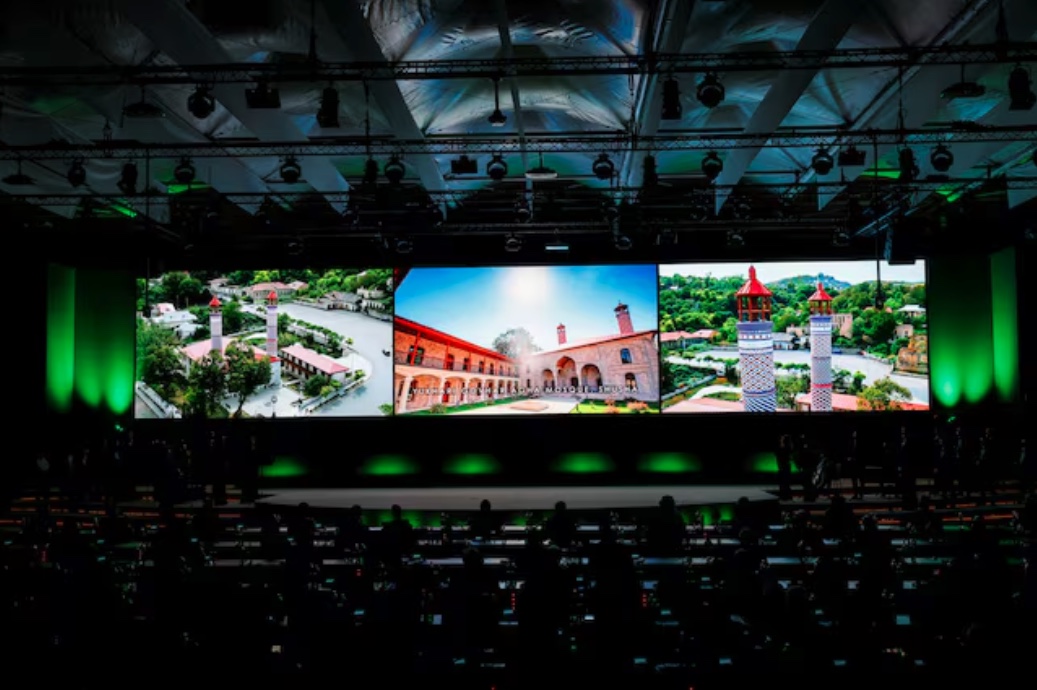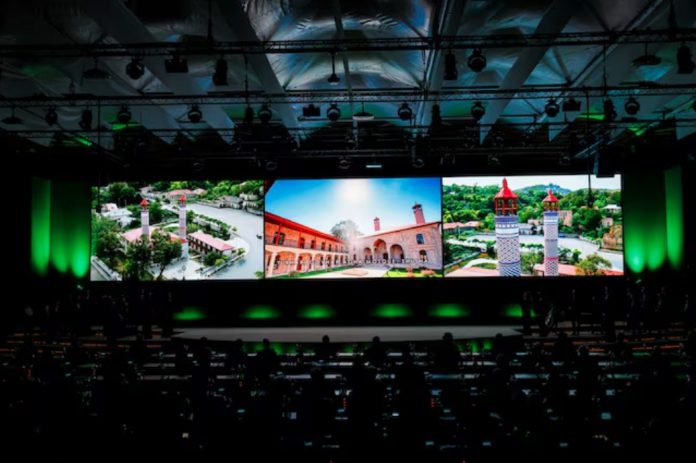งานหลักของประเทศเกือบ 200 ประเทศที่เข้าร่วมการประชุม COP29 ของสหประชาชาติ คือการเจรจาเพื่อบรรลุข้อตกลงที่ทำให้สามารถจัดหาเงินทุนหลายล้านล้านดอลลาร์สำหรับโครงการด้านสภาพภูมิอากาศทั่วโลก นี่คือสิ่งที่คุณควรรู้เกี่ยวกับการเจรจาเรื่องการเงินที่จัดขึ้นระหว่างวันที่ 11-22 พฤศจิกายนนี้
ประเทศที่มีความมั่งคั่งได้ให้คำมั่นในปี 2009 ว่าจะช่วยประเทศกำลังพัฒนาโดยการสนับสนุนเงินทุน 100 พันล้านดอลลาร์ต่อปี เพื่อช่วยเหลือในการปรับตัวให้เข้ากับการเปลี่ยนแปลงสภาพภูมิอากาศและการเปลี่ยนแปลงไปสู่พลังงานสะอาด โดยเริ่มต้นการชำระเงินในปี 2020 และครบถ้วนในปี 2022 การให้เงิน 100 พันล้านดอลลาร์จะสิ้นสุดในปีนี้
ตอนนี้ประเทศต่าง ๆ กำลังเจรจาเพื่อหาจำนวนเงินที่จะเพิ่มขึ้นในปีหน้า แต่บางประเทศยังไม่ยอมยืนยันจำนวนที่ชัดเจน จนกว่าจะทราบว่าใครจะมีส่วนร่วมบ้าง แทนที่จะแค่ตกลงกันเกี่ยวกับจำนวนที่แน่นอน ประเทศต่างๆ กำลังพิจารณาถึงแนวคิดที่มีการตั้งเป้าหมายหลายระดับ โดยมีจำนวนเงินหลักจากรัฐบาลของประเทศที่ร่ำรวย และจำนวนเงินที่มากขึ้นซึ่งรวมถึงแหล่งเงินทุนจากองค์กรเงินกู้หลายฝ่ายหรือจากนักลงทุนเอกชน
การชนะการเลือกตั้งของโดนัลด์ ทรัมป์ในสหรัฐอเมริกาได้ทำให้การประชุม COP29 ถูกให้ความสนใจ เพราะมีการคาดหวังว่าเขาจะหยุดการสนับสนุนเงินทุนด้านสภาพภูมิอากาศจากสหรัฐฯ ซึ่งจะทำให้เกิดช่องว่างในเป้าหมายใหม่ที่ประเทศอื่นๆ จะต้องพยายามเติมเต็ม นอกจากนี้ ยังมีการคาดการณ์ว่าเป้าหมายรวมที่ได้รับการตกลงที่ COP29 อาจจะน้อยลง เนื่องจากขาดการสนับสนุนจากเศรษฐกิจที่ใหญ่ที่สุดในโลก สหรัฐฯ ได้จัดสรรเงินกว่า 10 พันล้านดอลลาร์ในด้านการเงินเพื่อสภาพภูมิอากาศระหว่างประเทศในปีที่ผ่านมา ซึ่งน้อยกว่าจำนวน 31 พันล้านดอลลาร์ที่สหภาพยุโรปจัดสรร
จนถึงปัจจุบัน มีประเทศร่ำรวยไม่กี่ประเทศที่มีพันธกรณีที่จะจ่ายเงินทุนด้านสภาพภูมิอากาศตามที่สหประชาชาติได้กำหนด และพวกเขาต้องการให้ประเทศที่กำลังพัฒนาอย่างจีนและประเทศในกลุ่มอ่าวเริ่มมีส่วนร่วมในการจ่ายเงินบ้าง
ประเทศที่กำลังพัฒนากล่าวว่า จำนวนเงินที่จำเป็นในการจัดการกับการเปลี่ยนแปลงสภาพภูมิอากาศควรเป็นจุดเริ่มต้นในการเจรจา เพื่อให้แน่ใจว่าเป้าหมายสุดท้ายจะครอบคลุมความต้องการของพวกเขา โดยประมาณการส่วนใหญ่ระบุว่า ประเทศที่กำลังพัฒนาต้องการมากกว่า 1 ล้านล้านดอลลาร์ต่อปี เพื่อบรรลุเป้าหมายด้านสภาพภูมิอากาศและปกป้องสังคมจากสภาพอากาศที่รุนแรง
หลายประเทศได้ตั้งตัวเลขที่ต้องการจากการเจรจาครั้งนี้ ประเทศในอาหรับรวมถึงซาอุดีอาระเบียต้องการเป้าหมายการจัดหาเงินทุนที่ 1.1 ล้านล้านดอลลาร์ต่อปี โดย 441 พันล้านดอลลาร์จะมาจากรัฐบาลของประเทศที่พัฒนาแล้วในรูปแบบเงินช่วยเหลือ ประเทศอินเดีย, ประเทศในแอฟริกา และประเทศเกาะเล็กๆ ก็ได้กล่าวว่า ควรจะต้องระดมทุนมากกว่า 1 ล้านล้านดอลลาร์ต่อปี แม้ว่าจะมีมุมมองที่แตกต่างกันเกี่ยวกับจำนวนเงินที่ควรมาจากรัฐบาลที่ร่ำรวย
การเปลี่ยนแปลงสภาพภูมิอากาศได้เร่งตัวขึ้น กิจกรรมของมนุษย์ส่วนใหญ่ เช่น การเผาไหม้เชื้อเพลิงฟอสซิล ทำให้ค่าเฉลี่ยอุณหภูมิของโลกเพิ่มขึ้นประมาณ 1.3 องศาเซลเซียส ซึ่งเร่งให้เกิดน้ำท่วม, พายุเฮอริเคน, และคลื่นความร้อนที่รุนแรงขึ้น
แผนการลดการปล่อยก๊าซของหลายประเทศยังไม่เพียงพอที่จะชะลอการเปลี่ยนแปลงสภาพภูมิอากาศ และอาจนำไปสู่การร้อนขึ้นของโลกมากยิ่งกว่าเดิม นักวิทยาศาสตร์กล่าวว่า เส้นตายของสหประชาชาติในปีหน้าที่ให้ประเทศต่าง ๆ อัปเดตแผนการเปลี่ยนแปลงสภาพภูมิอากาศของตนเป็นโอกาสสุดท้ายในการหลีกเลี่ยงหายนะ
การเจรจาใน COP29 อาจส่งผลให้ประเทศต่าง ๆ เสนอแผนการด้านสภาพภูมิอากาศที่อ่อนแอลง เพราะพวกเขาอ้างว่าไม่สามารถจัดหางบประมาณในการดำเนินการแผนที่ทะเยอทะยานมากขึ้นได้
COP29: Why are countries fighting over climate finance?

The main task for nearly 200 countries at the U.N.’s COP29 climate summit is to broker a deal that ensures up to trillions of dollars in financing for climate projects worldwide.
Here is what you need to know about the Nov. 11-22 summit talks on finance.
WHAT IS THE GOAL?
Wealthy countries pledged in 2009 to contribute $100 billion a year to help developing nations cope with the costs of a transition to clean energy and adapting to the conditions of a warming world.
Those payments began in 2020 but were only fully met in 2022. The $100 billion pledge expires this year.
Countries are negotiating a higher target for payments starting next year, but some have been reluctant to confirm its size until it is clear which countries will contribute.
Instead, they are circling around the idea of a multi-layered target, with a core amount from wealthy countries’ government coffers, and a larger sum that includes financing from other sources such as multilateral lending institutions or private investors.
In the past, public money made up the bulk of contributions to the $100 billion goal.
WHO SHOULD CONTRIBUTE?
Donald Trump’s victory in the U.S. election has overshadowed the COP29 talks, because of expectations he will halt U.S. climate finance contributions.
That would leave a hole in any new global target that other donors would struggle to fill. Some climate negotiators also expect the overall target agreed at COP29 to be smaller, given the expected lack of contributions from the world’s biggest economy.
The U.S. provided nearly $10 billion in international climate finance last year, less than the European Union’s $31 billion contribution.
So far, only a few dozen rich countries have been obliged to pay U.N. climate finance and they want fast-developing nations, such as China and Gulf oil nations to start paying as well.
Beijing opposes this, saying that as a developing country it does not have the same responsibility as long-industrialised nations like Britain and the United States.
While China is already investing hundreds of billions of dollars in electric vehicles and renewable energy abroad, it does so on its own terms.
Any COP29 deal would need consensus approval.
HOW MUCH IS NEEDED?
Developing countries say the specific amount needed to tackle climate change should be the starting point for negotiations to ensure the final target adequately covers their needs.
By most estimates, developing countries need more than $1 trillion, opens new tab per year to meet their climate goals and protect their societies from extreme weather.
Many countries have come to the Baku talks with a number in mind.
Arab countries including Saudi Arabia want a funding target of $1.1 trillion per year, with $441 billion directly from developed country governments in grants.
India, African countries and small island nations have also said more than $1 trillion should be raised per year, but with mixed views on how much should come from wealthy governments.
The rich countries expected to provide the money have not specified a target sum, though the U.S. and the EU have agreed it must be more than the previous $100 billion target.
Some developed country diplomats say that, with national budgets already stretched by other economic pressures, a major increase beyond $100 billion is unrealistic.
WHY IT MATTERS
Climate change has accelerated. Human activities – mainly, burning fossil fuels – have heated up the planet’s long-term average temperature by around 1.3 Celsius, turbocharging disastrous floods, hurricanes and extreme heatwaves.
Countries’ plans for emissions cuts are not enough to slow climate change, and would instead lead to far worse warming.
Next year’s U.N. deadline for countries to update their national climate plans is a last opportunity to avert disaster, scientists say.
Negotiators have said a failure at COP29 to produce a major funding deal could result in countries offering weak climate plans on the grounds that they cannot afford to implement more ambitious ones.
Most of the world’s climate-friendly spending so far has been skewed towards major economies such as China and the United States. Africa’s 54 countries received just 2% of global renewable energy investments over the last two decades.
By Kate Abnett, Reuters

















